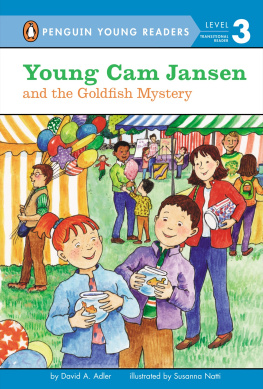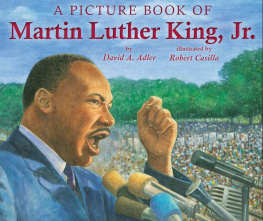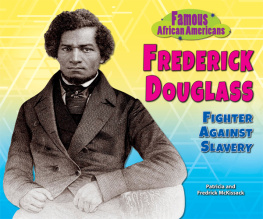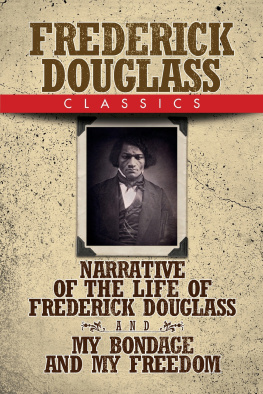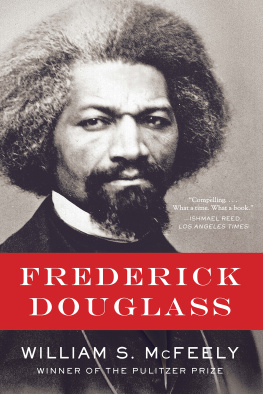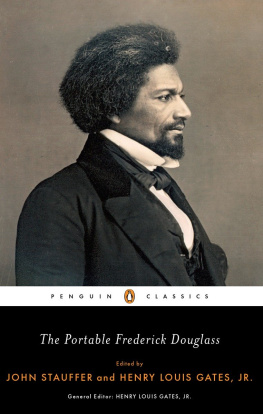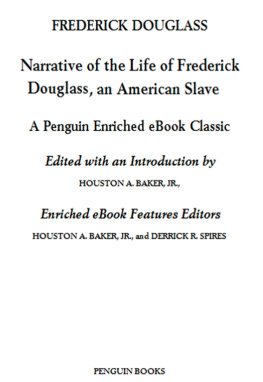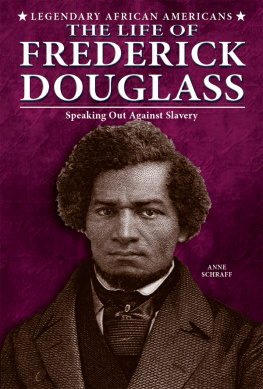For my nephew Donnie
D.A.A.
For Emily Carroll, the childrens librarian at Fitz
Simons Middle School, Philadelphia, Pennsylvania,
with thanks for her support
S.B.
Text copyright 1993 by David A. Adler
Illustrations copyright 1993 by Samuel Byrd
All rights reserved
Printed and bound in August 2010 at Tien Wah Press, Johor Bahru, Malaysia
8 10 12 11 9
Library of Congress Cataloging-in-Publication Data
Adler, David A.
A picture book of Frederick Douglass / David A. Adler ;
illustrated by Samuel Byrd. 1st ed.
p. cm.
Summary: A biography of the man who, after escaping slavery,
became an orator, writer, and leader in the abolitionist movement
in the nineteenth century.
ISBN 08234 1002 1
1. Douglass, Frederick, 1817? 1895Juvenile literature.
2. AbolitionistsUnited StatesBiographyJuvenile literature.
3. Afro-AmericansBiographyJuvenile literature. 4. Slavery
United StatesAnti-slavery movementsJuvenile literature.
[1. Douglass, Frederick, 1817? 1895. 2. Abolitionists. 3. Afro
AmericansBiography.] I. Byrd, Samuel, ill. II. Title.
E449.D75A35 1993 92-17378 CIP AC
973.8092dc20
[B]
ISBN 0-8234-1205-9 (pbk.)
HOLIDAY HOUSE is registered in the U.S. Patent and Trademark Office.
ISBN-13: 978-0-8234-1002-6 (hardcover)
ISBN-13: 978-0-8234-1205-1 (paperback)
ISBN-10: 0-8234-1002-1 (hardcover)
ISBN-10: 0-8234-1250-9 (paperback)
Other books in David A. Adlers Picture Book Biography series
A Picture Book of George Washington
A Picture Book of Abraham Lincoln
A Picture Book of Martin Luther King, Jr.
A Picture Book of Thomas Jefferson
A Picture Book of Benjamin Franklin
A Picture Book of Helen Keller
A Picture Book of Eleanor Roosevelt
A Picture Book of Christopher Columbus
A Picture Book of John F. Kennedy
A Picture Book of Simn Bolvar
A Picture Book of Harriet Tubman
A Picture Book of Florence Nightingale
A Picture Book of Anne Frank
A Picture Book of Sitting Bull
A Picture Book of Rosa Parks
A Picture Book of Robert E. Lee
A Picture Book of Sojourner Truth
A Picture Book of Jackie Robinson
A Picture Book of Paul Revere
A Picture Book of Patrick Henry
A Picture Book of Davy Crockett
A Picture Book of Thomas Alva Edison
A Picture Book of Louis Braille
A Picture Book of Thurgood Marshall
A Picture Book of Jesse Owens
Frederick Douglass was born a slave on a tobacco, corn, and wheat farm in Talbot County, Maryland. He was born in February 1818. His mother named him Frederick Augustus Washington Bailey
Fredericks mother was an African- American slave named Harriet Bailey. He never knew who his father was, but he did know that he was a white man. Some people said he was Captain Aaron Anthony, Fredericks first owner.
Soon after Frederick was born, he was taken to live with his grandmother, Betsey Bailey. He only saw his mother four or five times after that. She had to walk twelve miles at night to see her son and walk twelve miles back to be at work by sunrise. If she was late, she would be whipped. He wrote later, She would lie down with me, and get me to sleep, but long before I waked she was gone. She died when Frederick was about seven years old.
When Frederick was six he was taken to his masters house and put to work. He wrote later about how he lived as a slave. In the hottest summer and coldest win-ter I was kept almost naked no shoes, no stockings, no jacket, no trousers, nothing on but a coarse tow linen shirt reaching only to my knees. He was fed boiled corn meal called mush.
Frederick was wakened often by the cries of a slave being beaten. The first time that happened it was his own aunt Hester who was tied to a hook and whipped. Young Frederick was so frightened that he ran into a closet and hid.
When Frederick was eight years old he was taken to Baltimore to live as the slave of Sophia and Hugh Auld, relatives of his masters daughter. He ran errands for the Aulds and took care of their infant son, Thomas.
Young Frederick Bailey was Sophia Aulds first slave. She was a good- hearted woman and taught Frederick the alphabet. She began to teach him to read until her hus-band told her it was against the law. Hugh Auld said a slave should know nothing but to obey his master.
Sophia Auld stopped teaching Frederick, but he didnt stop learning. He took a book with him when he went out on errands. Poor white boys he met in the street helped him learn to read.
When Frederick was about twelve he told the boys, I am a slave for life! and he asked them, Have not I as good a right to be free as you have?
Frederick read the Bible and went to a church Sabbath school for black children. When he was fourteen he taught at the school.
In 1833 Frederick was sent to work for Thomas Auld, Hughs brother. The next year he was sent to work for Edward Covey, a poor farmer known to break the spirit of young slaves. Frederick worked hard. Even so, Covey beat him about once a week. Then, one summer morn-ing, Frederick fought back. Covey never beat him again.
The fight was the turning point in Fredericks life as a slave. I was nothing before, he said later. I was a man now.
On January 1, 1835, Frederick was sent to work for William Freeland. On Sundays the slaves had no work, and Frederick opened a secret Sabbath school and taught slaves to read.


